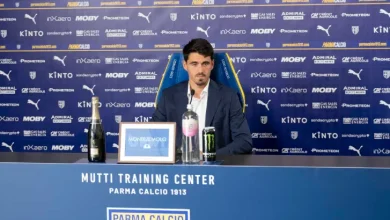What Man Utd’s Amorim can learn from Glasner about using 3-4-3

Oliver Glasner. Arne Slot. Ruben Amorim.
Three very different Premier League managers, each caught in a strange vortex of fan expectation and tactical intrigue.
Jack Grealish’s late winner for Everton ended Crystal Palace’s 19-game unbeaten run, but Glasner is among the most lauded head coaches in England. Liverpool have won five of their seven league matches, but as Slot looks to bed in multiple new arrivals, the reigning champions do not carry the same authority as last season.
Then there is Manchester United. A team without back-to-back league victories across Amorim’s 34 games in charge, but hopeful of correcting that on Sunday at Anfield. United have not won away against their old rivals since 2016, but Liverpool’s wobble gives fans some hope of a positive result.
Can Amorim’s United find a way to a league win at Anfield for the very first time since January 2016? And can Palace’s victory against Liverpool last month work as a blueprint for United and other teams using a 3-4-3?
How is Glasner’s 3-4-3 different from Amorim’s system?
Although Palace and United share a starting formation and willingness to attack directly, their managers differ in their tactical intentions.
Glasner does not look to dominate possession, with his team averaging 41.3 per cent of the ball this season — the third lowest in the Premier League. Instead, he has crafted Palace into a compact defensive unit that can counter-attack quickly by punching passes through central areas.
Conversely, Amorim prefers his side to be the protagonists in matches, controlling possession and playing on the front foot. United — who average 53 per cent possession this season — make greater efforts to circulate possession through the back five compared to Palace. This is partially due to a desire to bait opposition teams onto them to create space in behind.
Amorim likes his team to bait the opposition into pressing his back line (Gareth Copley/Getty Images)
United look to play the ball into the channels more than Palace, where Amorim’s wing-backs or attacking midfielders are entrusted to beat opponents in one-v-one duels before making crucial decisions in the final third.
Additionally, there is a difference in how the players execute their coach’s plans. As The Athletic outlined here in February, Palace enjoyed more success in a 3-4-3 than United last season, thanks to a collection of players better suited to the tasks Glasner required of them.
Jean-Philippe Mateta is a more Premier League-hardened striker compared to those who have led the line at Old Trafford across the last 18 months, while Palace enjoyed more consistency and attacking quality at wing-back. Both sides seek to attack with pace, but Palace have been far more successful in manufacturing dangerous goalscoring chances in the attacking third. There is a level of sharpness to Palace’s actions (such as in their corners) that is a cut above others in the league.
Both sides can defend in a 5-2-3, but Palace prefer to defend in an aggressive mid-block that prefers to wait until opposition teams approach the halfway line before hunting for possession. Glasner has drilled his players into a stubborn out-of-possession unit, where there is little confusion from his centre-backs as to when and where they have to jump early to press, or when they have to shift over into wider spaces to cover for their wing-backs. This leaves the central midfield pairing better protected, making his team less liable to the sort of counter-attacks that have proved a United weakness in recent seasons.
Glasner is not as wedded to the tactical shape as Amorim. Palace play a 3-4-3 because the Austrian views it as the formation that best fits his most important players, rather than something his players have to conform to.
“There is too much discussion about the system. The system is not important,” Glasner told Sky Sports this year. “Habits are important, the patterns and how you want your players to behave on the pitch. That is much more important.
“In my career, I have used every single system. I got promoted in Austria with a 4-4-2, then we switched to a 3-4-3. In Wolfsburg, we reached the Champions League with a 4-2-3-1. In Frankfurt, they played with three at the back before and it fit the squad.
“I always look at what system might suit the players we have best. My favourite system is 4-4-2, but do we have the right players for this?”
Broadly speaking, then, the Palace version of 3-4-3 has more square pegs placed into square holes compared to what is found at United. Glasner does not seek to dominate games in the same way as Amorim, instead opting to hurt teams through central areas.
Can Amorim copy Glasner’s methods at United?
Only in a limited capacity. In November 2024, in one of his final games as Sporting CP head coach, Amorim’s side needed only 28 per cent of the ball to beat Manchester City 4-1 in the Champions League. By then, his move to United had been confirmed and he was asked if he would bring the same approach to his new club.
“We cannot transport one reality to another,” he said. “United cannot play the way we play, they cannot be so defensive. It’s good to beat City. But I’ll be living in a different world; we’ll have to start from a different point.”
Amorim’s version of a 3-4-3 seeks to control possession to a greater degree than Glasner’s version, because of a cultural and tactical expectation for Manchester United to dominate games. Amorim understands that while he is in charge of an uneven squad of varying talent, the money spent on players and the historical record of the club mean fewer teams will open up and play against United.
Manchester United do not have a player with the progressive passing skills of Adam Wharton (Eddie Keogh/Getty Images)
This is a challenge Amorim recognises. His team might attack through midfield more if they had more players with the progressive passing skills of Adam Wharton, but there’s no guarantee that opposition teams wouldn’t make greater strides to close off central areas if such a change occurred at Old Trafford. Without such a player, and with different team expectations, Amorim asks for his middle centre-back to push into midfield areas to help “clean the space” (in the head coach’s words) and distribute the ball via bounce passes into the channels.
This is but one difference in tactical intention that brings contrasting results to those found with Glasner. Still, the hope for Amorim is that — one day — his tactical idea will “evolve” and could turn his side into a more versatile threat than many others found in the Premier League.
Are there lessons United can learn from Palace’s 2-1 win in September?
In short, yes: defend in an aggressive mid-block and stifle the supply to Ryan Gravenberch.
At Selhurst Park in September, Palace’s front three pressed in a particularly narrow shape, matching Liverpool’s early build-up patterns and looking to limit any passes to Gravenberch. (Who was also marked closely by Wharton.)
Unable to get the ball to their best ball carrier in midfield, Liverpool struggled to progress the ball quickly between the penalty areas. Last season, Slot preferred his team to attack in a quasi-4-2-4, with Trent Alexander-Arnold and Mohamed Salah dovetailing to great effect down the right-hand side. Alexander-Arnold’s departure — coupled with multiple new signings — has given Slot several tactical problems to solve at once.
A trip to Anfield is never easy, but Liverpool do not get the ball from Point A to Point B with the same zip as before. Glasner’s team regularly forced Liverpool back when they forayed past the halfway line, with Ismaila Sarr regularly jumping up on Alexis Mac Allister early in the first half.
This prompted the Argentina international to recycle possession between his defenders, rather than work the ball forward.
Amorim appears to have already taken this note on board. His attacking midfielders played much closer to Benjamin Sesko in United’s 2-0 win over Sunderland before the international break, defending in a more compact manner akin to what is found at Palace.
Glasner’s back five were also comfortable with members jumping up onto Liverpool players in space, or shuffling over to stymie movement down the wings. For every movement Liverpool made, either inside or out wide, Palace had prepared a counter-movement, throwing sand into their gears.
Amorim’s men have looked to start matches in an aggressive, determined manner this season, hunting for early goals that might build confidence. It’s an approach that Palace also took to Liverpool in September, moving the ball with purposeful runs from their centre-forward and attacking midfielders on the counter-attack.
Another relevant tactical note is about Liverpool goalkeeper Giorgi Mamardashvili.
The Georgian came in for the injured Alisson against Chelsea — the Brazilian was excellent against Palace — in the last fixture before the international break. He is left-footed but received the majority of his passes on his right at Stamford Bridge. The time Mamardashvili needs to get the ball out to his stronger foot opens up a minor pressing opportunity for any sneaky United players willing to gamble with the occasional, aggressive pressing attempt.
Read: Mason Mount is likely to retain his place in the starting XI on Sunday.
This isn’t Amorim’s first encounter with Slot at Anfield. The two sides played out an entertaining 2-2 draw in January, one that repeatedly saw Lisandro Martinez pop up in the final third as a surprise goalscoring threat. Amorim will be without the injured Martinez on this occasion, but there is reason to believe a deployment of the 3-4-3 could trouble Liverpool again.
This weekend’s fixture gives Amorim the opportunity to earn himself a statement win at Anfield. United fans will hope he finds a way to seize it.





